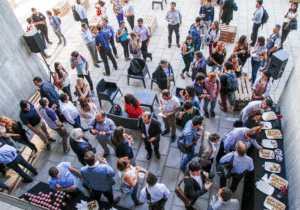Crowdsourcing – getting readers to analyse, write, and send in photos
If you can get your network to do most of the reporting it is not only cheap. It will keep your website or newsletter credible and authentic.
Readers are often the best journalists.
I mean it. And I certainly mean it for publications and websites embedded and devoted to corporations, agencies and causes.
For most types of newsgathering, data analysis, research and dissemination, there is always someone in your company, organization or network who has the time, talent and inclination to do it. And for most good stories in your network, the best storytellers are often the people involved themselves.
But how do you cost-effectively find these colleagues and experts, and how do you consistently get them to report and deliver appealing and creative stories, pictures and videos, that can be publishable on your website or publication?

Unleashing the power of the many. (Photo;: Centro de Innovación UC Anacleto Angelini Creative Commons license)
Users generate leads
The University Post – an English-language media at the University of Copenhagen – has had some success in delivering a steady flow of new content from users. And this in spite of the fact that the University Post has been operated on a limited budget.
So dear colleagues and network!
I would like to offer you my time and my advice. I would like to meet up with you, and maybe do some field work in your place of work. Hopefully I can then offer a few recommendations and easy tips while I am there.
Almost half of the University Post content is from volunteer contributions by staff and students at the University. Most of this content is in specific formats and templates or already specified genres for reporting. In this way, the University Post effectively ‘crowdsources’ a lot of its journalism through the use of set formats and templates for reporting.
This can be applied to any organization with internal or external newsletters or websites that need credible, and authentic content from readers.
Here are a couple of examples:
In our ‘Dorms Disclosed’ format, students write reviews of their own housing/dormitories. Another example is ‘Lab and Library’, where PhD students write a short essay about what it is exactly that they are interested in, right now.
Other University Post formats have included a ‘Research Relay’ of professor interviews, where they nominate the next interviewee themselves, and a ‘War of the Wardrobes’ based on readers’ photos of student styles around the world’s campuses.
The formats are successful in their own right – generating excellent journalistic pieces on subjects of niche interest. But they are also successful in terms of leads to further content, often by the users themselves.
According to the Tow Center For Digital Journalism’s guide, crowdsourcing in journalism can be analysed from the point of view of entry points for audience input: Audiences can be voting, witnessing, sharing news and specialized expertise, contributing data or unique knowledge, completing tasks, volunteering time or skills to help create a news story, engaging audiences and joining in call-outs.
After trying out several formats for user–generated content, I have come up with a short list of things that a good format should have, and each of them have one or several audience entry points. This list is at the back of my mind, whenever we discuss a new format at our editorial meetings.
A good format for user-generated content works if:
- it has a good, snappy ‘ title’, which is easily associated to the format and subject area, like ‘Lab and Library’. Readers get a good idea about what it is, it rolls off the tongue, and it is easily remembered
- it generates content from the users themselves, with minimum editing time
- the call-out for the content from users must be easy, systematic and scalable
- the published content elicits new content from readers and/or from participants
- the published content should be share-able and search-able: Each piece of new content should draw new readership to old content within the same concept
- it is fascinating, curiosity inducing
- delivers something that our own newsroom can’t deliver
- is edgy and personal
- leads to other reported stories by student reporters
At editorial meetings on the University Post, we regularly set off time to brainstorm over which new format could cover a specific topic. Every now and again, we hit on something good, like our recent ‘All Abroad!’ format for getting University of Copenhagen students who study abroad to ‘review’ their cities and universities.
The customer/reader
My experience has taught me that the readers are willing to help you with content for your media. It is just a question of finding a format for them to engage, and finding a call-out that will reach them.
In one way, the crowdsourcing philosophy on the University Post ties in with a wider movement in business, namely towards customer-orientation. To use a concept from Seth Godin in his recent book, we want to create a ‘tribe’ from our readership, our ‘customers’ or ‘colleagues’, who are so passionately engaged with us that they collectively become the authors of their own news.
No media or website, and not even ours, will ever reach that sweet spot – a format where users generate brilliant content to infinity with no editing work for a responsible webmaster, copy editor or hired communicator.
But I am always learning! Maybe you have some ideas?




Skriv en kommentar
Want to join the discussion?Feel free to contribute!